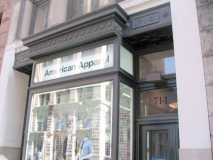Do architects design house numbers as parts of buildings anymore? Today house numbers are usually indicated by metal numbers attached separately above the door, or if we’re really talking cheap, by glued-back numbers that get slapped on transoms or on front doors. In a recent stroll on Broadway on Open House NY weekend, I noticed that Broadway in Noho (north of Houston) has several ornate house number designs, so I decided to explore this a little further.
LEFT: 543 Broadway (according to Jim Naureckas’ essential Songlines) was originally home to the offices of McCall’s magazine founder James McCall. A women’s monthly, it published from 1880 through 2002 (it was called The Queen from 1880-1897 and Rosie from 2001-2002, after comedienne Rosie O’Donnell took over editorial content. McCall’s still exists in online form, selling dress patterns as it did throughout its history (there’s no more magazine, however.) The present building at 543 is not the original McCall’s offices: it was built in 1903.
RIGHT: At 578, northeast corner of Prince, we find a new wrought-iron above-the-transom house indicator, this one employing the handsome Cochin typefont. 568-578 was built in the 1890s by prolific NYC architect George B. Post. From 1827-1895 theatre Niblo’s Garden stood here: perhaps its most famed production was The Black Crook, a Faustian musical that ran for several years beginning in 1866. One of its chief innovations was the performance of tights-clad dancing girls, risqué for the time.
LEFT: 700 Broadway, NE corner of East 4th (across from the old Tower Records locale, which has lain empty for two years now [2008]). This is another George B. Post brownstone building, originally called the Schermerhorn Building when built in 1891, and now home to the National Audubon Society. Sorry about the inferior flash photo; in November the east side of Broadway is in deep shadow at 1PM. A better picture is on the linked site above.
704-706 Broadway has got it going on, with a pair of Ionic columns, two nymphs, and a ribbon-and-wreath building number plate with a stylish 704-706 carving. Additional detail here. The building dates to 1896-97 and was constructed by the prolific De Lemos and Cordes firm, which later designed Macy’s Broadway and West 34th locale as well as the massive Siegel-Cooper Dry Goods store on 6th between West 18th and 19th.
You have to look carefully at 714 Broadway to see its number, rendered in cast iron above the transom. The NY Times had an article in 1878 about how a classic building with Doric columns was demolished there that year. The present 11-story tower was built in 1896.
Probably my favorite in this stretch of Broadway is at 722, with an ornate grille-and wreath number over the front doorway. Other than emporis.com’s assertion it was constructed in 1895, though, I don’t know much about the place.
Today’s final house number is 802, sexton’s office for Grace Church at 800, 804 Broadway at West 10th Street. The Gothic Revival church complex was designed by renowned architect James Renwick Jr. (his first great work in the city) and completed in 1846.
Designed to be a companion piece to Trinity Church (whose present incarnation was also finished in 1846) it was built where Broadway curves northwest at 10th Street so it could be seen from Trinity (sight lines were much better then, of course, with no intervening skyscrapers)
11/28/08









